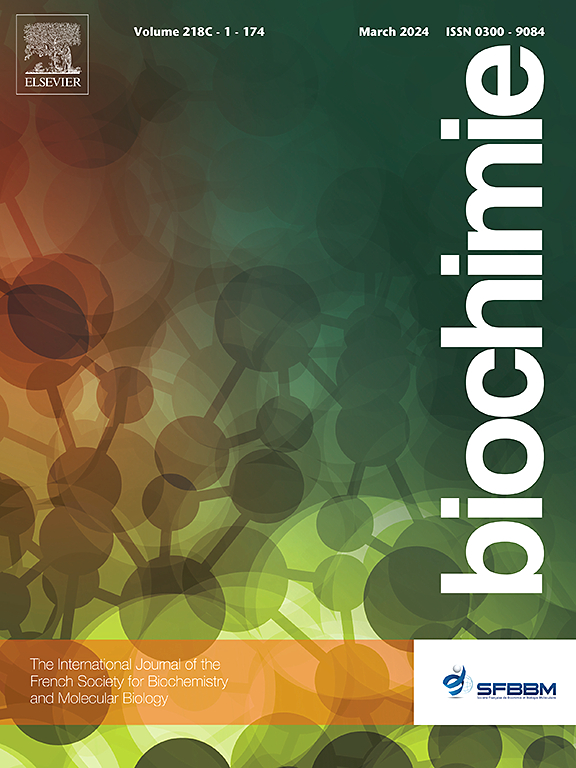The modulation of low molecular weight sulfur compounds levels in visceral adipose tissue of TLR2-deficient mice on a high-fat diet
IF 3
3区 生物学
Q2 BIOCHEMISTRY & MOLECULAR BIOLOGY
引用次数: 0
Abstract
Obesity treatment requires an individualized approach, emphasizing the need to identify metabolic pathways of diagnostic relevance. Toll-like receptors (TLRs), particularly TLR2 and TLR4, play a crucial role in metabolic disorders, as receptor deficiencies improves insulin sensitivity and reduces obesity-related inflammation. Additionally, hydrogen sulfide (H2S) influences lipolysis, adipogenesis, and adipose tissue browning through persulfidation.
This study investigates the impact of a high-fat diet (HFD) on low molecular weight sulfur compounds in the visceral adipose tissue (VAT) of C57BL/6 and TLR2-deficient mice. It focuses on key enzymes involved in H2S metabolism: cystathionine beta-synthase (CBS), cystathionine gamma-lyase (CGL), 3-mercaptopyruvate sulfurtransferase (MPST), and thiosulfate sulfurtransferase (TST).
In C57BL/6 mice on HFD, MPST activity decreased, while CBS level increased, potentially compensating for H2S production. In contrast, TLR2-deficient mice on HFD exhibited higher MPST activity but reduced level of CBS and CGL activity, suggesting that TLR2 deficiency mitigates HFD-induced changes in sulfur metabolism. TST activity was lower in TLR2-deficient mice, indicating an independent regulatory role of TLR2 in TST activity. Elevated oxidative stress, reflected by increased glutathione levels, was observed in wild-type mice. Interestingly, cysteine and cystine were detectable only in the VAT of the C57BL/6 ND group and were absent in all other groups. The capacity for hydrogen sulfide production in tissues from TLR2−/−B6 HFD group was significantly lower than in the C57BL/6 HFD group.
In conclusion, TLR2 modulates sulfur metabolism, oxidative stress, and inflammation in obesity. TLR2 deficiency disrupts H2S production and redox balance, potentially contributing to metabolic dysfunction, highlighting TLR2 as a potential therapeutic target for obesity-related metabolic disorders.
高脂饮食对tlr2缺陷小鼠内脏脂肪组织中低分子量硫化合物水平的调节。
肥胖治疗需要个性化的方法,强调需要确定诊断相关性的代谢途径。toll样受体(TLRs),特别是TLR2和TLR4,在代谢紊乱中起着至关重要的作用,因为受体缺乏可以改善胰岛素敏感性并减少与肥胖相关的炎症。此外,硫化氢(H2S)通过过硫化作用影响脂肪分解、脂肪形成和脂肪组织褐变。本研究探讨了高脂肪饮食(HFD)对C57BL/6和tlr2缺陷小鼠内脏脂肪组织(VAT)中低分子量硫化合物的影响。重点研究参与H2S代谢的关键酶:胱硫氨酸β -合成酶(CBS)、胱硫氨酸γ -裂解酶(CGL)、3-巯基丙酮酸硫转移酶(MPST)和硫代硫酸盐硫转移酶(TST)。在HFD的C57BL/6小鼠中,MPST活性降低,而CBS水平升高,可能补偿H2S的产生。相比之下,TLR2缺陷小鼠在HFD中表现出更高的MPST活性,但CBS和CGL活性水平降低,这表明TLR2缺陷减轻了HFD诱导的硫代谢变化。TLR2缺失小鼠的TST活性较低,表明TLR2对TST活性有独立的调节作用。在野生型小鼠中观察到氧化应激升高,反映为谷胱甘肽水平升高。有趣的是,半胱氨酸和胱氨酸仅在C57BL/6 ND组的VAT中检测到,而在其他所有组中均不存在。TLR2-/- b6 HFD组的组织产生硫化氢的能力显著低于C57BL/6 HFD组。综上所述,TLR2调节肥胖的硫代谢、氧化应激和炎症。TLR2缺乏会破坏H2S的产生和氧化还原平衡,可能导致代谢功能障碍,这表明TLR2是肥胖相关代谢紊乱的潜在治疗靶点。
本文章由计算机程序翻译,如有差异,请以英文原文为准。
求助全文
约1分钟内获得全文
求助全文
来源期刊

Biochimie
生物-生化与分子生物学
CiteScore
7.20
自引率
2.60%
发文量
219
审稿时长
40 days
期刊介绍:
Biochimie publishes original research articles, short communications, review articles, graphical reviews, mini-reviews, and hypotheses in the broad areas of biology, including biochemistry, enzymology, molecular and cell biology, metabolic regulation, genetics, immunology, microbiology, structural biology, genomics, proteomics, and molecular mechanisms of disease. Biochimie publishes exclusively in English.
Articles are subject to peer review, and must satisfy the requirements of originality, high scientific integrity and general interest to a broad range of readers. Submissions that are judged to be of sound scientific and technical quality but do not fully satisfy the requirements for publication in Biochimie may benefit from a transfer service to a more suitable journal within the same subject area.
 求助内容:
求助内容: 应助结果提醒方式:
应助结果提醒方式:


